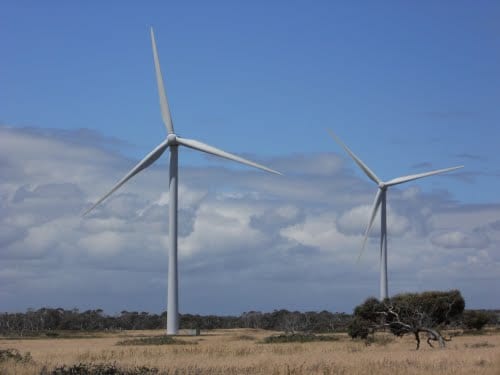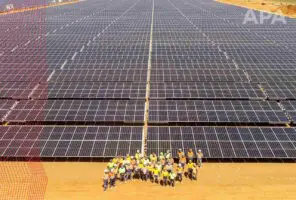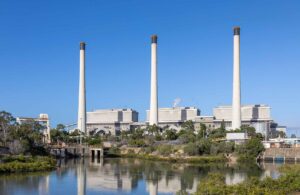Victoria’s Andrews government says it will set a renewable energy target of 40 per cent by 2025, making it the latest state in Australia to introduce a target for large-scale renewables development more ambitious than that of the federal Turnbull government and underlining the political divide over wind and solar.
Victoria’s labor government intends to end an investment drought in the state by aiming to lift its share of renewable energy from 15 per cent to 25 per cent by 2020.
Then it will establish a new target jumping to 40 per cent by 2025, which will require some 5,400MW of large scale wind, and large and small scale solar to be built in less than one decade. That compares to its current capacity of 1,200MW of large-scale wind and 930MW of small-scale solar.
The new targets were announced on Wednesday by Victorian Premier Daniel Andrews, along with his minister for energy and climate Lily D’Ambrosio, while they were marking the arrival of the first turbine blades at the Ararat Wind Farm.

The targets will be met with the help of reverse auctions modelled on the successful scheme pioneered by the ACT government which aims to reach 100 per cent renewable energy by 2020. Details will be released later this year and the legislation enacted in early 2017.
Some 1,800MW of large-scale wind and solar will need to be built by 2020, although D’Ambrosio insists it will not come at an extra cost. The 2025 target will be met by reverse auctions and will be “additional” to the national target, and D’Ambrosio says the costs will be limited to just a matter of “cents per week” to consumers.
Victoria’s move highlights a growing division between Labor and the conservative parties on renewable energy. On the national level, the federal Coalition has cut the target and caused a near three-year drought in investment, which D’Ambrosio said the state is now trying to break.
South Australia and Queensland – as well as the ACT – also have more ambitious renewable energy targets, although D’Ambrosio says Victoria will be the first to put theirs into legislation. The conservative states of NSW and Western Australia base their policies on the national target, with NSW recently rated the worst state for renewable investment.
The Victorian government auction schemes will be split into “solar only” auctions and others that will be technology neutral, but will most likely favour wind energy. The exact share is yet to be decided.
In an interview with RenewEconomy on Wednesday, D’Ambrosio said the first round of auctions were expected to be held in 2017, with the goal of generating 1,800MW of new capacity and getting it built by 2020.
“We think it is ambitious. And very achievable, and is what we need,” she told RE.
For the Victorian economy, D’Ambrosio said the scheme was expected to generate 3,000 jobs by 2020, before any costs were imposed, and then another 4,000 additional jobs by 2023/24.
In terms of emissions, the scheme is expected to deliver around a 12 per cent reduction in electricity sector greenhouse emissions by 2034-35, the government said.
In broader terms, the announcement of the new VRET means that Australia’s three mainland Labor states – Victoria, South Australia (50 per cent by 2025) and Queensland (50 per cent by 2030) – now have markedly more ambitious targets than the federal government.
South Australia is expected to pass its 50 per cent renewable energy target this year, in fact it effectively reached that target in May – nearly a decade ahead of schedule – and the state’s Labor government has pledged to focus all efforts on getting the state as close to 100 per cent renewable energy as possible.
Queensland’s Labor government has set a 50 per cent renewable energy target by 2030, and recently doubled its short-term large scale solar target to 120MW, and already leads in rooftop solar, with 1.5GW of installed capacity – making it the second biggest power station after the Gladstone coal generator.
The ACT, meanwhile, leads the country on renewables ambition, while Tasmania is already there, given the right hydro conditions.
Federal Labor, too, has promised to set a national target of 50 per cent renewables by 2030 – a goal the Turnbull government has repeatedly attacked as economically “reckless” and described as an effective tax on electricity.
For Victoria, D’Ambrosio said that making the state’s scheme complementary to the Commonwealth’s was also about helping to save the national RET.
“Investors have lost faith in the national target, but we are restoring the confidence needed to invest. We’ve developed Victorian renewable energy targets that generate thousands of new jobs, particularly in regional Victoria, while also cutting Victoria’s greenhouse gas emissions,” she said.
“Growing renewable energy means growing jobs, and we want a big boost to both right here in Victoria,” Andrews added.
“The world is shifting to renewable energy – it creates jobs, drives growth, and protects our environment – and Victorians want to be at the forefront of that.”
Energy analysts agreed that the scheme was likely to keep a lid on wholesale electricity prices. Morgan Stanley analyst says it will be a negative for brown coal generators, including AGL Energy, which owns Loy Yang A and is the only listed company with a major share of the brown coal generation fleet.
“This development reinforces our view of the long-term supply-demand outlook in the NEM, with our view of flat nominal pool prices into the long term,” Koh wrote in a note to clients. “We therefore view this development as a longer term negative for AGL and a positive for (Origin Energy).
Green groups welcomed the Andrews government’s ambition on renewables.
“The targets announced today by the Premier and energy minister will see Victoria double its wind power capacity by 2020 and quadruple it by 2025, as well as supporting large-scale solar projects in the north of the state,” said Environment Victoria CEO Mark Wakeham.
Victoria is back in the renewable energy business. Big solar will be key for ambtitious 40% by 2025 #VRET #springst pic.twitter.com/Uf4w1cVBRQ
— Yes 2 Renewables (@Yes2Renewables) June 14, 2016
“(The) VRET provides a lifeline for manufacturing in Portland, Glen Waverly, Geelong and the western suburbs of Melbourne,” said Friends of the Earth spokesperson Leigh Ewbank.
“With an estimated 10,000 jobs created in renewable energy, this is what the transition looks like.
“All available polling shows strong community support for renewable energy. Creating jobs, cutting pollution and acting on climate change is something all parties can support,” said Leigh Ewbank.
The Clean Energy Council also welcomed the 40 per cent VRET, particularly from a state that is home to some of the world’s most heavy polluting coal-fired power plants.
“Victoria faces many challenges in transitioning away from emissions-intensive forms of generation towards new renewable energy, and it’s vital for the community that the shift is managed well,” said CEC chief Kane Thornton.
“Victoria’s ambitious target to reach 40 per cent renewable energy by 2025 makes the state a very attractive destination for clean energy investment at a time when activity in the sector is ramping upsignificantly.
“We have seen about 450 megawatts of projects committed nationally in the past three months alone, so this move by Victoria is smart timing – and should see Victoria claim a big share of the renewable energy pie out to 2025 and beyond,” Thornton said.








